People
Friends and Family Remember Artist Ida Applebroog, Whose Wry, Feminist-Tinged Work Defied Categorization
The artist has died at age 93.
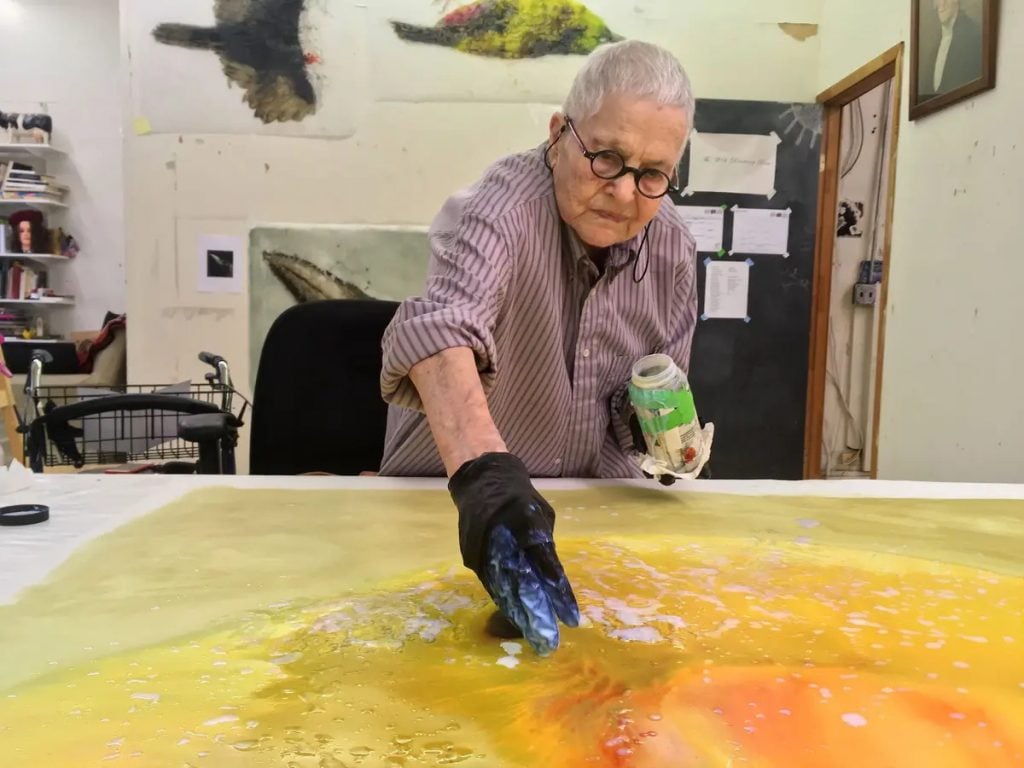
The artist has died at age 93.

Sarah Cascone

The artist Ida Applebroog, known for paintings, sculptures, and video works that addressed issues of politics, violence, and gender with a wry and provocative sense of humor, died at her Manhattan home on October 21. She was 93. Hauser & Wirth gallery, which represented Applebroog since 2009, confirmed her passing.
“Ida’s work was shot through with an anger and ferocity, often delivered slyly, so it takes a beat to catch up, and her feminist politics resonate now as much as ever,” scholar Jo Applin told Artnet News in an email. “It is why she is so relevant, and pertinent to many of the conversations I have with students today. The uneven power dynamics of the world are something she placed at the heart of her paintings. She was so thoughtful, so incisive and utterly original in how she saw the world. I learned so much from Ida and her work, and suspect I will continue to do so for a long time yet to come.”
Born Ida Applebaum to Orthodox Jewish parents in the Bronx in 1929, the artist married her high-school sweetheart, Gideon Horowitz, in 1950. But in becoming a professional artist in her 40s, she chose her own surname, Applebroog, in defiance of the societal expectation that a woman should take a man’s name.
Horowitz died in 2015; Applebroog is survived by the couple’s four children, Beth B., Paul Horowitz, Ned Horowitz, and Debra Dodd; sister Gloria Bornstein, seven grandchildren, and one great granddaughter.
Though Applebroog drew from an early age, her career path was not a direct one. She enrolled at New York’s Institute of Applied Arts and Sciences to study graphic design in 1948, and joined an advertising firm, but quit after just six months due to the sexism she experienced. Work as a freelance illustrator and at the arts division of the New York Public Library followed, before she moved to Chicago with her growing family in 1956.
“When I was a child, Ida was first and foremost, a mother and a wife, and so her artwork was done in the basement mostly during the evenings after she had put us to bed,” B wrote in an email. “She made jewelry, then began working on copper enamel pieces. I was often drawn to the basement to work alongside her.” (A filmmaker, she spent 15 years filming her mother at work in the studio, footage that became the 2016 documentary Call Me Applebroog.) “These were the times when most women were not allowed the voice or place to pursue their careers primary to the obligations of the home.”
When the family’s youngest child began kindergarten, Applebroog enrolled in the School of the Art Institute of Chicago, studying there from 1965 to ’68. But her practice is rooted in a bout of mental illness she experienced in 1969, at age 40. She had rented her first art studio only a few months before, after to moving to San Diego for her husband’s job.
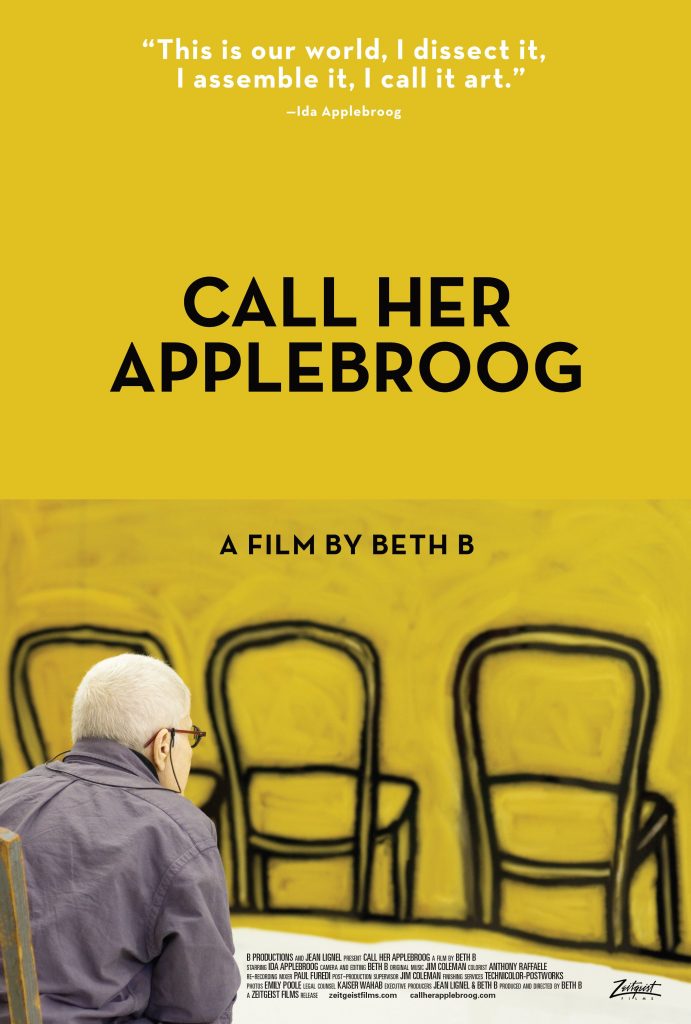
Call Her Applebroog, Beth B’s documentary film about her mother, artist Ida Applebroog. Courtesy of Zeitgeist Films.
Severely depressed, Applebroog “withdrew from the world entirely, for a period hardly able to speak at all,” she said of the time. When words failed her, the artist checked into the city’s Mercy Hospital and began to draw—a breakdown became a breakthrough.
“These extraordinary pieces documented her inner struggles, which seemed to be the pivot point that took her from being a housewife and mother, to committing to a life as an artist,” B, who was 13 at the time of her mother’s hospitalization, wrote.
After Applebroog’s recovery, the resulting works were packed away and forgotten, until they were rediscovered by her studio assistants in 2009. Blending abstraction and figuration, the deeply personal graphite, India ink, and watercolor drawings remained unseen until 2016, when the Institute of Contemporary Art Miami staged the exhibition “Ida Applebroog: Mercy Hospital.”
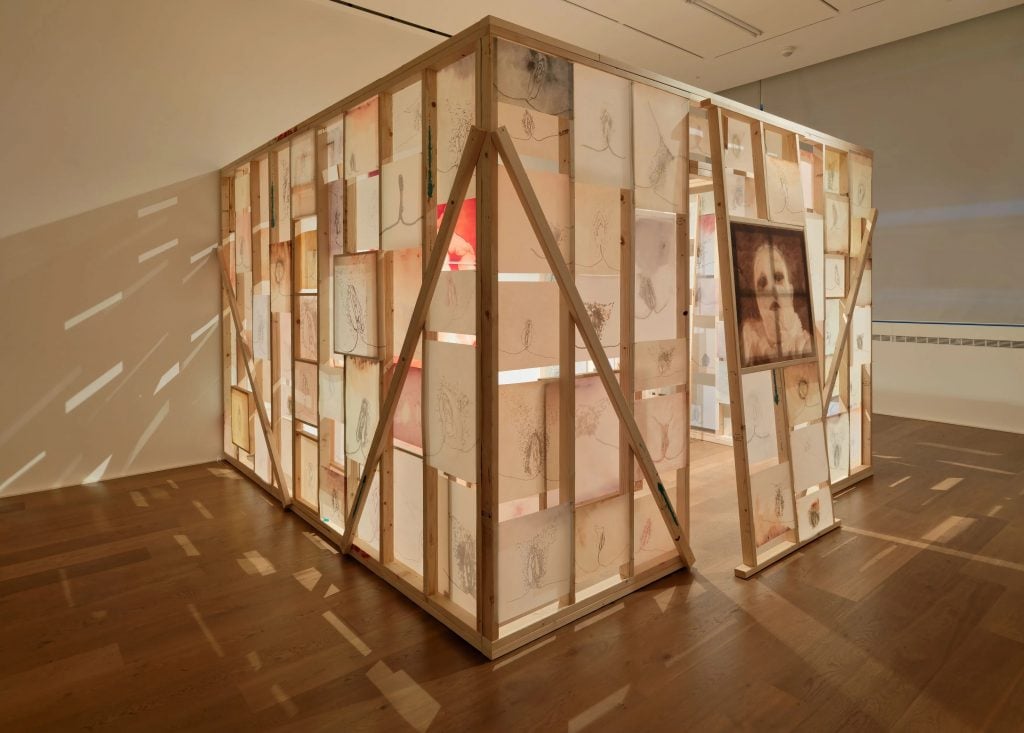
Ida Applebroog, Monalisa (2009). Photo by Alex Delfanne, ©Ida Applebroog, courtesy of Hauser and Wirth.
“The Mercy Hospital drawings allowed her to draw herself back to life, back to herself, leading from catastrophic breakdown to a creative, personal and political breakthrough,” Applin wrote in the accompanying catalogue.
Upon her return home, Applebroog began working in her bathroom, creating 150 ink drawings of her vagina based on her naked reflection in the mirror during a nightly bathing ritual. This work was not meant to be sexual, but was instead about self exploration. These drawings, too, stayed private for decades, until her 2010 solo show “Monalisa,” at Hauser & Wirth in New York, which displayed them hanging from the frame of a small hut structure.
Applebroog first came to notice, beginning in 1977, by mailing out darkly humorous self-published booklets she called “Stagings” to artists and writers. The covers featured cryptic phrases—the first one was titled I Can Do Anything. Inside she would repeatedly create the same sparsely captioned, cartoon-like drawings.
“I made a mailing list, of writers and artists I knew or liked until it was finally at 500 people. And I’d take all the books in a shopping cart to the Canal Street post office and mail them in bulk,” Applebroog told Hauser & Wirth. “There are a lot of people who have them still. And there were people who wrote back and said, ‘Who are you!? Don’t ever send me anything like that again.’”
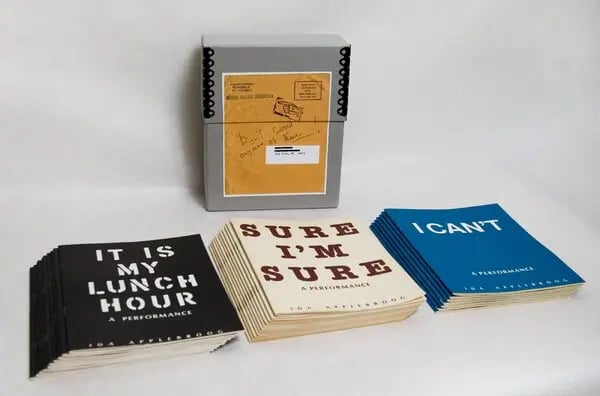
Three piles of booklets from Ida Applebroog’s series A Performance (1977–81). Photo by Emily Poole, courtesy of Hauser and Wirth.
In 1974, Applebroog moved to New York, setting down roots in a Soho loft that would serve as both home and studio for the rest of her life. The next year, she would adopt her chosen name, eventually joining the feminist Heresies Collective alongside critic Lucy Lippard and artists including May Stevens, Joan Snyder, and Pat Steir.
But Applebroog long defied the label of feminist artist—or any other label, including not restricting herself by artistic medium. She didn’t want her practice to be limited to painting, or sculpture, or politics. She wanted to be an artist in the broadest sense of the word, letting her art speak for itself.
“It’s hard to say what your work is about, but for me, it’s about how power works: male over female, parents over children, governments over people, doctors over patients,” Applebroog told Art21 in 2005.
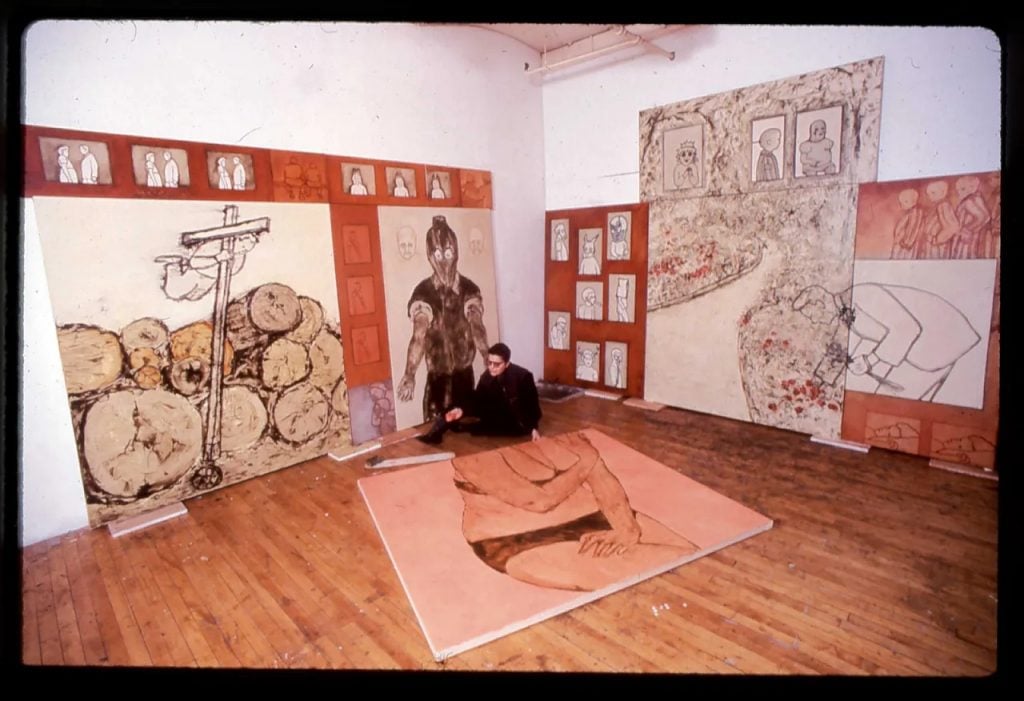
Ida Applebroog in her New York City studio (1987). Photo by Gianfranco Gorgoni, courtesy of Hauser and Wirth.
Applebroog joined New York’s Ronald Feldman Gallery, where she would show for over 25 years, in 1981. (Since 2009, she has been represented by Hauser & Wirth.)
“She would get her images from life, from everywhere in the culture. And she would recontextualize them and make new associations,” Marco Nocella, who met the artist when he began working at Feldman in 1986, recalled in a phone interview. “I was the gallery’s director of sales, so many people would want to know the meaning of Ida’s work. What struck me is that conceptually, it was open-ended and it was meant to be completed by the viewer. For me, that was new to art history and what I knew about artists.”
Applebroog’s work has appeared in the 1987 and 2012 editions of Documenta in Kassel, Germany, and can be found in the collections of the Corcoran Gallery of Art in Washington, D.C., as well as New York’s Whitney Museum of American Art, Metropolitan Museum of Art, Solomon R. Guggenheim Museum, and Museum of Modern Art, among other institutions. The artist was the recipient of a MacArthur genius grant in 1998 and a 2009 Anonymous Was a Woman Award.
More Trending Stories:
Four ‘Excellently Preserved’ Ancient Roman Swords Have Been Found in the Judean Desert